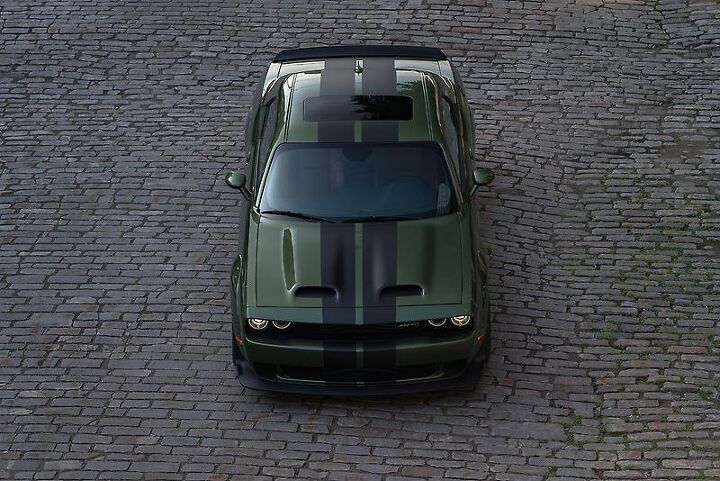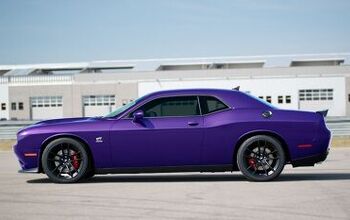Manual Dodge Challenger Hellcat May Be Gone for Good

Dodge decided to nix the six-speed manual for Challenger Hellcat models last November, indicating that it would be a temporary issue. The automaker allegedly planned to deliver an updated version and said it was actively calibrating the powertrain to see what worked ahead of pulling the old version from the assembly line. It was minor news and everyone following the industry promptly forgot about it, assuming three-pedal Challengers would be back in action before anyone noticed.
It’s now four months later and the option is still nowhere in sight.
On Tuesday, Road & Track realized you still could not configure the coupe with a manual transmission if you also wanted the Hellcat’s 6.2-liter supercharged V8. This sent waves of panic through the automotive press, who similarly failed to realize that the car still wasn’t available with a clutch. In fact, only the relevant Mopar forum goblins seemed aware that the configuration was still absent — proving that nature has a plan for even the most humble of creatures.
They’ve been griping about the missing manuals since at least December (effectively doing our jobs for us), with the conversation gradually shifting from tepid annoyance to near-total defeat. Commenters almost immediately became pessimistic, stating that Dodge’s response was to repeatedly deny that the manual was gone for good was likely bogus. While a few remained optimistic, others quickly pointed out that the company has suggested that the current model would be replaced by a plug-in hybrid by 2024. They believed it would be pointless for the automaker to reintroduce a configuration that less than a third of customers have historically wanted, especially since the model’s discontinuation was looming.
From R&T:
While I only noticed this issue today, Challenger enthusiast forums have been talking about it since 2021. I asked Dodge what’s up with the stick-shift Hellcat, and a spokesperson explained that the six-speed manual was removed from the configurator late in the 2021 model year. The spokesperson described it as a temporary situation and said that a revised calibration for this powertrain combo will be coming that will allow the stick-shift Hellcat to go on sale again. The spokesperson was not able to say when ordering will re-open for the manual Challenger Hellcat, but specified that production of stick-shift models was suspended in November 2021.
It’s a disappointment, for sure, because the manual Hellcat was a charming mix of modern performance and retro engagement. But fear not: Challenger R/T models with the 5.7-liter V-8 and Scat Packs with the 6.2-liter V-8 are both still available with a six-speed manual.
Having driven those models with the Tremec TR-6060, it’s a little difficult for me to get bent out of shape over the Hellcat becoming automatic only. I believe the Challenger is the American grand tourer par excellence and it’s easily my favorite performance vehicle that lacks unassuming bodywork. If you’re looking for a powerful, engaging automobile with the kind of comfort that seems to be totally missing absent from today’s lineups, you’d be hard-pressed to find a better deal. But it’s hard to say that the manual configuration is a game-changer, especially on the higher trims.
As my tastes ping-pong between hulking, difficult-to-park automobiles with giant motors and squirrely, turbocharged compacts, I never thought I would gripe about driving a Challenger in an urban environment. I’ve kept several land yachts in New York City and my only real complaints about transitioning into a big Dodge was the brutal decline in fuel economy vs the highway. Then I spent several days navigating a manual-equipped R/T around town, accidentally punishing myself in the process. The clutch and gearbox are fine for cruising unencumbered across the country. But it gradually starts to become an annoyance when you have to spend a lot of time in heavy traffic, diminishing enjoyment.
While not overly stiff on the R/T or Scat Pack models, the Hellcat’s clutch is allegedly a bit of a workout due to it having the larger ZF-Sachs with 258-millimeter discs. Worse yet, the performance disparity grows in tandem with horsepower. I couldn’t see myself getting one even if a truckload of cash arrived at my door. Why purchase one of the fastest vehicles in Dodge’s lineup only to handicap it by selecting the manual transmission? The driving experience between trims is largely similar, with differences only emerging after their respective powertrains are given a genuine workout. That doesn’t mean we shouldn’t still have the option to ruin the car as we please. It just means there are better ways of configuring this particular vehicle.
However, Dodge has continued assuring everyone this will be temporary and my tastes don’t need to be yours. If you’re seeking an 807-horsepower goliath with a stick, there’s still a razor-thin chance the company will hook you up. But I’m thinking the utility of such a setup begins to evaporate somewhere around 500 hp.
[Images: Stellantis]

A staunch consumer advocate tracking industry trends and regulation. Before joining TTAC, Matt spent a decade working for marketing and research firms based in NYC. Clients included several of the world’s largest automakers, global tire brands, and aftermarket part suppliers. Dissatisfied with the corporate world and resentful of having to wear suits everyday, he pivoted to writing about cars. Since then, that man has become an ardent supporter of the right-to-repair movement, been interviewed on the auto industry by national radio broadcasts, driven more rental cars than anyone ever should, participated in amateur rallying events, and received the requisite minimum training as sanctioned by the SCCA. Handy with a wrench, Matt grew up surrounded by Detroit auto workers and managed to get a pizza delivery job before he was legally eligible. He later found himself driving box trucks through Manhattan, guaranteeing future sympathy for actual truckers. He continues to conduct research pertaining to the automotive sector as an independent contractor and has since moved back to his native Michigan, closer to where the cars are born. A contrarian, Matt claims to prefer understeer — stating that front and all-wheel drive vehicles cater best to his driving style.
More by Matt Posky
Latest Car Reviews
Read moreLatest Product Reviews
Read moreRecent Comments
- W Conrad I'm not afraid of them, but they aren't needed for everyone or everywhere. Long haul and highway driving sure, but in the city, nope.
- Jalop1991 In a manner similar to PHEV being the correct answer, I declare RPVs to be the correct answer here.We're doing it with certain aircraft; why not with cars on the ground, using hardware and tools like Telsa's "FSD" or GM's "SuperCruise" as the base?Take the local Uber driver out of the car, and put him in a professional centralized environment from where he drives me around. The system and the individual car can have awareness as well as gates, but he's responsible for the driving.Put the tech into my car, and let me buy it as needed. I need someone else to drive me home; hit the button and voila, I've hired a driver for the moment. I don't want to drive 11 hours to my vacation spot; hire the remote pilot for that. When I get there, I have my car and he's still at his normal location, piloting cars for other people.The system would allow for driver rest period, like what's required for truckers, so I might end up with multiple people driving me to the coast. I don't care. And they don't have to be physically with me, therefore they can be way cheaper.Charge taxi-type per-mile rates. For long drives, offer per-trip rates. Offer subscriptions, including miles/hours. Whatever.(And for grins, dress the remote pilots all as Johnnie.)Start this out with big rigs. Take the trucker away from the long haul driving, and let him be there for emergencies and the short haul parts of the trip.And in a manner similar to PHEVs being discredited, I fully expect to be razzed for this brilliant idea (not unlike how Alan Kay wasn't recognized until many many years later for his Dynabook vision).
- B-BodyBuick84 Not afraid of AV's as I highly doubt they will ever be %100 viable for our roads. Stop-and-go downtown city or rush hour highway traffic? I can see that, but otherwise there's simply too many variables. Bad weather conditions, faded road lines or markings, reflective surfaces with glare, etc. There's also the issue of cultural norms. About a decade ago there was actually an online test called 'The Morality Machine' one could do online where you were in control of an AV and choose what action to take when a crash was inevitable. I think something like 2.5 million people across the world participated? For example, do you hit and most likely kill the elderly couple strolling across the crosswalk or crash the vehicle into a cement barrier and almost certainly cause the death of the vehicle occupants? What if it's a parent and child? In N. America 98% of people choose to hit the elderly couple and save themselves while in Asia, the exact opposite happened where 98% choose to hit the parent and child. Why? Cultural differences. Asia puts a lot of emphasis on respecting their elderly while N. America has a culture of 'save/ protect the children'. Are these AV's going to respect that culture? Is a VW Jetta or Buick Envision AV going to have different programming depending on whether it's sold in Canada or Taiwan? how's that going to effect legislation and legal battles when a crash inevitibly does happen? These are the true barriers to mass AV adoption, and in the 10 years since that test came out, there has been zero answers or progress on this matter. So no, I'm not afraid of AV's simply because with the exception of a few specific situations, most avenues are going to prove to be a dead-end for automakers.
- Mike Bradley Autonomous cars were developed in Silicon Valley. For new products there, the standard business plan is to put a barely-functioning product on the market right away and wait for the early-adopter customers to find the flaws. That's exactly what's happened. Detroit's plan is pretty much the opposite, but Detroit isn't developing this product. That's why dealers, for instance, haven't been trained in the cars.
- Dartman https://apnews.com/article/artificial-intelligence-fighter-jets-air-force-6a1100c96a73ca9b7f41cbd6a2753fdaAutonomous/Ai is here now. The question is implementation and acceptance.



































Comments
Join the conversation
While I'd like to see the manual be available for those who want it -- the 8 speed auto DaimChryFCAntis installs is excellent. All of my performance cars until my SRT were sticks. Not a paddle fan -- but the manual mode with the shift selector is pretty similar to a sequential manual -- and when traffic gets gummed up -- full auto is so much better to deal with it. Who knows why it's not being offered. I'm guessing one of Tavares' spreadsheet jockeys went through the books and found warranty related numbers with the sticks that made both his bowtie and graduation cap tassel hanging off his fancy MBA sheepskin spin.
But what about those stripes? Stripes that run off the upper surfaces, across the bumper, down the fascias, and right off the bottom look like you accidentally drove under a street line painter. End them on the hood and trunk, as God intended. She knows good design.